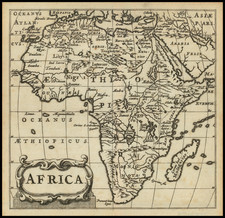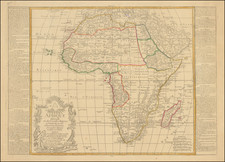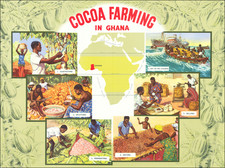Decorative example of Coronelli's 2-sheet map of Africa, featuring up to date information from modern reports and recent discoveries regarding the sources of the Nile River.
Coronelli's map is full of topographical features and place names, and more accurate than many maps of the period. Coronelli claims to have been the first to correctly describe the source of the Nile, in Lake Tsana, Abyssinia.
Beside the fascinating detail, the maps are richly decorated with animals and scenes of horsemen in combat or hunting the animals. The large title cartouche on the west sheet is surrounded by several indigenous animals including ostrich, crocodile, lions, elephant and camel. On the other sheet is a large scene in Central Africa with an angel blowing a trumpet, while another holds the corner of the tent and a scribe standing on a globe records information concerning the origin of the Nile on the side of the tent. Also included in the scene is an allegorical figure representing Father Nile with the river flowing from his overturned urn.
Vincenzo Maria Coronelli (1650-1718) was one of the most influential Italian mapmakers and was known especially for his globes and atlases. The son of a tailor, Vincenzo was apprenticed to a xylographer (a wood block engraver) at a young age. At fifteen he became a novice in a Franciscan monastery. At sixteen he published his first book, the first of 140 publications he would write in his lifetime. The order recognized his intellectual ability and saw him educated in Venice and Rome. He earned a doctorate in theology, but also studied astronomy. By the late 1670s, he was working on geography and was commissioned to create a set of globes for the Duke of Parma. These globes were five feet in diameter. The Parma globes led to Coronelli being named theologian to the Duke and receiving a bigger commission, this one from Louis XIV of France. Coronelli moved to Paris for two years to construct the King’s huge globes, which are 12.5 feet in diameter and weigh 2 tons.
The globes for the French King led to a craze for Coronelli’s work and he traveled Europe making globes for the ultra-elite. By 1705, he had returned to Venice. There, he founded the first geographical society, the Accademia Cosmografica degli Argonauti and was named Cosmographer of the Republic of Venice. He died in 1718.









![[Africa] Prima Tavola](https://storage.googleapis.com/raremaps/img/small/96586.jpg)


![[ Air Travel Routes in Africa ] Ministre de l'air regie Air Afrique](https://storage.googleapis.com/raremaps/img/small/89402.jpg)

![[Wall Map of Africa] L'Afrique Divisee en ses Principales Parties et ses Isles Tire des Relations les plus Recentes . . . 1782](https://storage.googleapis.com/raremaps/img/small/91459.jpg)